Overall Best Panfish Line: Trout SOS 2-pound test Copolymer Line (Similar to Monofilament)
Strongest Panfish Line: Braid 6-pound test Low-Vis Green Sufix 832
Fluoro Panfish Line: 4-Pound Vicious Fishing Panfish
Best Line for Bobber Fishing Panfish: Regular 8-pound Mono
Conclusion: Pick the Right Fishing Line for Your Panfish Situation
Appendix: Fishing Line Test Data
When targeting panfish, Monofilament / Copolymer, Fluorocarbon, and Braid line are all capable of catching fish. I have caught plenty of Bluegill, Crappie, and Perch on all of them. However, I have found that varying circumstances or personal preferences call for different types of line. For instance, when I string up a Zebco Spincast with a bobber rig, I use a 6-8 pound Mono, but when I am jigging a 1/32 oz head with a spinning reel, I will use a 2 pound SOS (Copolymer – similar to Mono) or 6 pound Braid.
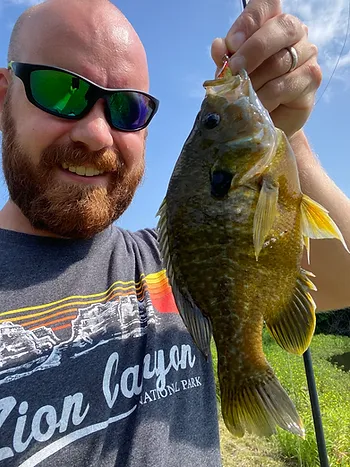
Bluegill caught with braid line
Mono, Flouro, and Braid exude different characteristics. I was curious about how these different characteristics compare when fishing for panfish. I decided to test these lines to determine the pros and cons of each. I decided to test the following characteristics of each line:
Cast Distance – The distance I was able to cast. I used my panfish rod and reel with three different lines and measured how far I could cast in my backyard. I cast 10 times with each type of line.
Visibility – How visible the line is underwater. I put the three types of line in a bowl of water to see how visible they were relative to each other.
Memory – How much the line will curl from being wound in the reel over time. Memory is when the line is not smooth and straight but coils like a helix. I took note of how much the three lines curled over time.
Strength – The line’s ability to hold weight. I took note of how strong the line was. I got a sense when tying knots and getting my jig caught in the brush of the line’s strength.
Abrasion Resistance – The line’s ability to withstand wear and not fray. I noted how much the line frayed over time.
Ease of Tying Knots – The ability to tie knots. I noted how difficult it was to tie knots with each line.
Sink or Float – The buoyancy of the line. In a bowl of water, I pushed the line below the water’s surface to see if it sank or floated. The water tension keeps the slack of the line on its surface. But when jigging, a sinking line can add more weight than a floating line.
For a comparison of Mono and Braided Line across many different fishing techniques read: Braided Fishing Line vs Mono: The Ultimate Guide for Every Fishing Technique.
Type of Panfish Lines Tested
I tested Braid, Copolymer (similar to Monofilament but a little better), and Fluorocarbon. For the Braid, I used a 6-pound test Low-Vis Green Sufix 832 with 8 braided fibers. This line is advertised to be comparable to 2-pound test Monofilament line. For the Monofilament, I bought a 2-pound test SOS, which is technically a Copolymer line. Copolymer is made in the same way as Monofilament but is a blend of multiple materials instead of just one. I wanted to test the high-end Copoly / Mono line and found that Trout SOS was a popular panfish line. Therefore, I decided to use this instead of a standard 2-4 pound test Mono. For the Fluorocarbon, I experimented with a 4-pound test, Vicious Fishing Panfish Fluoro.
After testing each line, my overall favorite for panfish was the Trout SOS 2-pound test Copolymer line. The SOS was smooth, easy to tie knots, had the best casting range, and was strong. I did not have memory problems, which is the general knock of Monofilament type lines. I just loved fishing with the SOS. I felt like I could sling the 1/32 oz jig wherever I wanted which was not the case for any of the other tested lines.
While I loved the SOS, the other lines had some excellent characteristics to consider, and I wanted to break down my thoughts and test results for each line tested.
Overall Best Panfish Line: Trout SOS 2-pound test Copolymer Line (Similar to Monofilament)
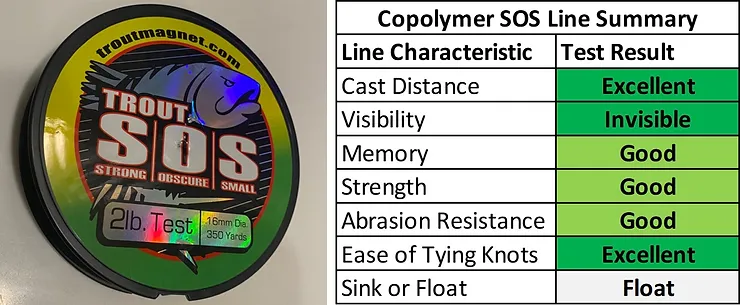
The SOS 2-pound test line enabled me to cast the same 1/32 oz jig 5 feet further than the 6-pound Braid (2-pound Mono equivalent) and 10 feet further than the 4-pound Flouro. When I was fishing my panfish pond in the backyard, this extra casting distance made a huge difference. I could pinpoint Bluegill holes and put my jig wherever I wanted. The cast was very smooth, and I felt the line had plenty of strength for panfish. The downside to the 2-pound test is that if I accidentally hooked into a larger fish, I’d be concerned about snapping the line.
Strongest Panfish Line: Braid 6-pound test Low-Vis Green Sufix 832

The Sufix Braid line was super strong. I had a difficult time cutting it with my nail clippers. If you are fishing for Crappie and Bluegill but are concerned that you might accidentally hook into a big Bass – consider fishing with this line! The Sufix Braid was tough stuff, I got snagged several times and was able to pull very hard without snapping it. I also liked the visibility of the line. This is because when jigging, I could clearly see when a fish struck my bait. The line floating from the water tension would pulse, signaling a fish.
I was able to cast a 1/32 oz jig just short of the SOS but further than the Fluoro. Occasionally, when casting the braid, the line would dig into the spool and get caught. This would cause a misfire. I kept track of how many misfires I would have, and it was 2 out of every 10 casts. That is more frequent than I was expecting and is super annoying. Another downside was that the line was difficult to tie knots with. As far as visibility, Braid sticks out like a sore thumb. I liked this characteristic when jigging panfish because the line twitches when a fish strikes. Some anglers may be concerned about the Braid’s visibility, that it might prevent fish from biting. When using Braid, I caught a similar amount of panfish as the other line types. When panfishing, I think the line’s visibility is a personal preference.
Fluoro Panfish Line: 4-Pound Vicious Fishing Panfish
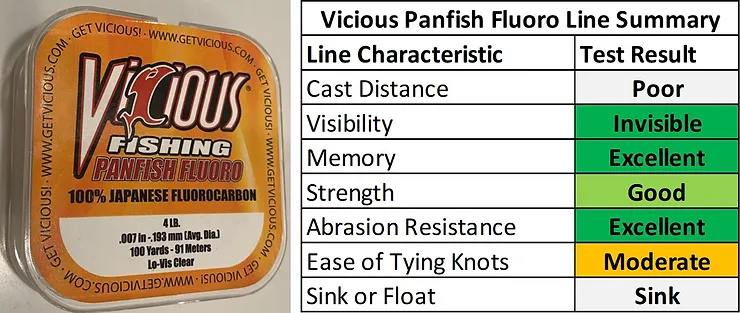
Even though I conducted my test at the end of Summer, Panfish Fluoro is the preferred line for ice fishing. Fluorocarbon line is known for its strength and invisibility underwater. And I can say that these characteristics are true for the Vicious Fishing Panship Fluoro. The Fluoro line came up short in terms of casting distance. When I was throwing a 1/32 oz jig, I could not cast as far or as accurately as I wanted to. Clearly, when ice fishing, this is not a concern. The Fluoro properties are perfect for ice fishing because it does not absorb water and is taught with no memory. The line signals a bite very well when ice fishing. However, I would use different lines during the warmer months due to its poor casting abilities.
Best Line for Bobber Fishing Panfish: Regular 8-pound Mono
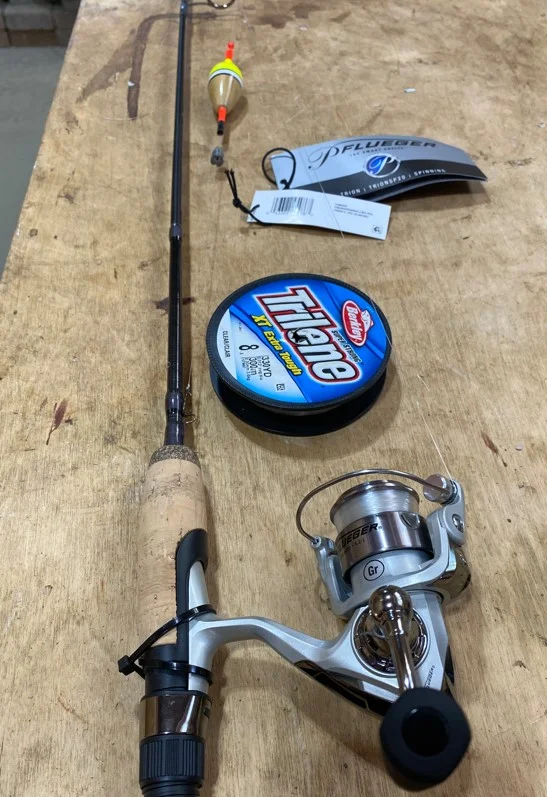
When I string up my kid’s poles with a bobber rig for panfish, I use 6- to 8-pound Mono. This is simply because this line is versatile and economical. I am not concerned about strength or castability. I am simply looking for a durable and cheap line. A line that can withstand the wear from a Zebco Spincast (even though the picture above is my son’s lefty spinning reel). And a line that is forgiving when a big fish is on, but one that I can snap if they get a bad snag. Regular Monofilament is perfect for these conditions. My test did not include the standard Monofilament, but I know from teaching all three of my kids – don’t get fancy, just get Mono.
Conclusion: Pick the Right Fishing Line for Your Panfish Situation
Testing the three line types was very insightful. I was surprised to discover how much I would love the SOS Trout line for panfish. My general rule of thumb is the angler that covers the most water will catch the most fish. Since the SOS had superior casting distance compared to the rest, I will be stringing up my spinning reel with this line. But I also learned that Braid and Fluoro have their place when panfishing. If there is a possibility that I could hook into a lunker – Braid will be my go-to line. If I am ice fishing, I will throw on the Panfish Fluoro.
Each line has strengths and weaknesses. Understanding your preferences and situation will help you decide which line is best for you. The more informed you are, the better equipped you will be to catch a load of panfish!
Appendix: Fishing Line Test Data
Table 1: Cast Distance with a 1/32 oz Jig with my Panfish Rod and Reel
Casting Data

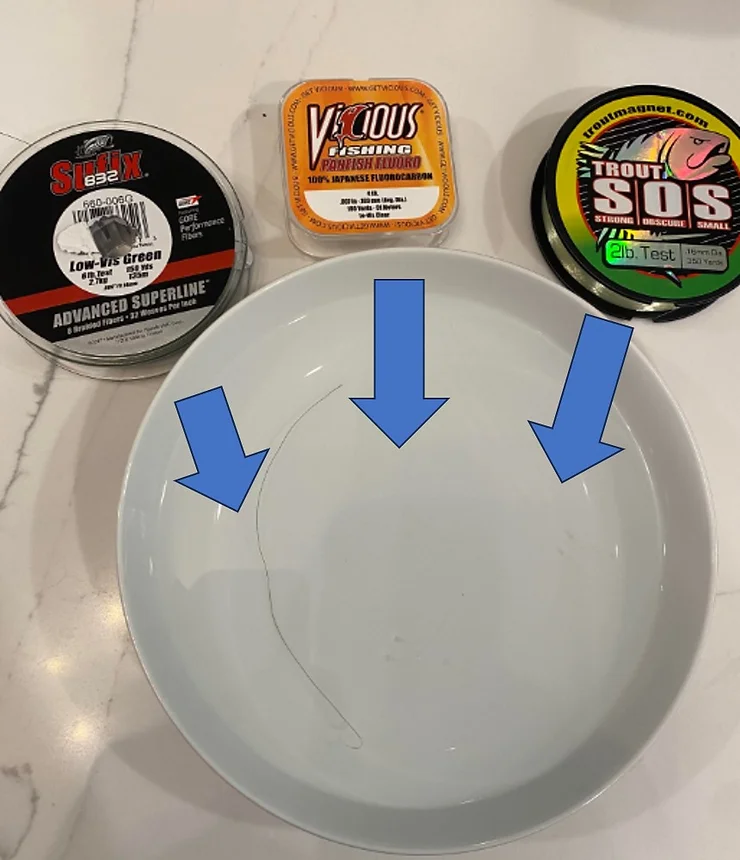
Visibility and Floating Test: The Copoly and Fluoro were not visible underwater. When pushed underwater, the Copoly was the only line to float.

0 Comments